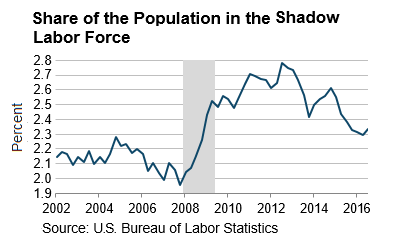Outside Looking In: Why Has Labor Force Participation Increased?
Ellyn Terry
FRBAtlanta, November 22, 2016
The labor force participation rate (LFPR) is an estimate of the share of the population actively engaged in the labor market. The LFPR has increased about 30 basis points over the past year (from the third quarter of 2015 to the third quarter of 2016)—a modest reversal in the precipitous decline in the LFPR that began in 2008. What accounts for this stabilization and—given the demographic and cyclical forces in play—how much longer can it last?
The following is perspective through the lens of the reasons people give for not participating in the labor force. Perhaps the component most responsive to changes in labor market conditions is what I will refer to as the “shadow labor force,” which is made up of people who are not in the official labor force and are not actively seeking employment, but who say they want a job. (This group includes people discouraged over job prospects.) During tough times, the share of the population in the shadows rises, and during good times it falls. In the third quarter of 2016, about 2.3 percent of the population fell into this category—down from a high of 2.8 percent but still a bit above prerecession levels (see the chart).

But focusing solely on the decline in the shadow labor force to explain the recent reversal in the LFPR would be a mistake. In fact, high unemployment in the aftermath of the Great Recession was accompanied not only by a rise in the share of the shadow labor force, but also by an increase in the share of the population who said they didn’t currently want a job—because of either a health issue or engagement in some other activity. Although some of this likely reflects trends already at work before the recession, some of it was also probably a cyclical response to weak job opportunities.
The chart below shows how these various factors cumulatively contribute to the decline in the LFPR between the third quarter of 2007 and the third quarter of 2016. It shows that, in addition to a larger share in the shadow labor force, the reasons for the decline between 2007 and 2016 also stemmed from a greater age-adjusted share who were too sick or disabled to work (purple) or in school instead of working (light blue). Interestingly, the share out of the labor force but wanting a job (dark blue) actually exerted the smallest downward force on LFPR of all of these three reasons. The green section represents the impact of the baby boomers: an increasing share of the population of retirement age. Partly offsetting this shift in the age distribution was a decrease in the propensity of these workers to actually retire (orange).

The next chart shows that almost all the nonparticipation factors that had put downward pressure on the LFPR since 2007 have reversed course and contributed positively to an increase in the LFPR during the past year. In particular, there was a decline in the share of the population who cited nonparticipation because of poor health or enrollment in school or were otherwise wanting but not looking for work. This decline in the schooling and illness nonparticipation rates is particularly noteworthy because it stands in contrast to the increasing trends that were in place prior to the recession (to read more, visit our LFP Dynamics page).

The only significant factor continuing to depress the LFPR during the past year is the impact of an increasing share of the population in age groups with relatively low labor force attachment. This factor brings me to the second question I posed earlier in this post: What will this picture look like going forward? Unfortunately, I think the answer is that it’s very hard to say.
Other things equal, it seems reasonable to think that the nonparticipation rates attributable to age-adjusted schooling and poor health will eventually revert to the upward trends occurring before the recession, a reversion that will push down the LFPR. Probably the biggest wild card for the future is what will happen with decisions concerning retirement (and hence older individuals’ LFPR). The trend toward retiring later in life has risen and fallen a couple of times during the past two decades. The positive role that later retirement has played in mitigating the overall decline in the LFPR in recent years—coupled with the steadily increasingshare of the population approaching traditional retirement age—suggests that deferred retirement will be an especially important factor to keep an eye on. This point is nicely illustrated in this piece ![]()
![]() by our colleagues at the Kansas City Fed, who look at the role of later retirement in reducing the rate of outflow of people from the labor force.
by our colleagues at the Kansas City Fed, who look at the role of later retirement in reducing the rate of outflow of people from the labor force.
Note: Data on the reasons for not participating are available in the data download section of the Labor Force Dynamics page, which we will update every quarter (data for the third quarter are coming soon).

 Ellyn Terry, an economic policy analysis specialist in the Atlanta Fed’s research department
Ellyn Terry, an economic policy analysis specialist in the Atlanta Fed’s research department